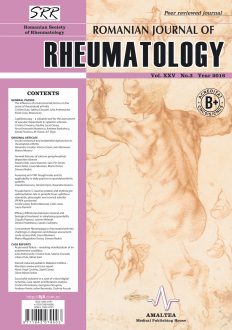SELECT ISSUE

Indexed

| |

|
|
|
| |
|
|
|

|
|
|
|
|
|
| |
|
|
HIGHLIGHTS
National Awards “Science and Research”
NEW! RJR has announced the annually National Award for "Science and Research" for the best scientific articles published throughout the year in the official journal.
Read the Recommendations for the Conduct, Reporting, Editing, and Publication of Scholarly work in Medical Journals.
The published medical research literature is a global public good. Medical journal editors have a social responsibility to promote global health by publishing, whenever possible, research that furthers health worldwide.
Assessing anti-TNF trough levels and its applicability in daily practice in spondyloarthritis patients
Claudia Deaconu, Daniela Opris and Ruxandra Ionescu
ABSTRACT
Objective. The purpose of the present study was to assess the relevance of therapeutic drug monitoring in spondyloarthritis patients, by determining drug serum levels and anti-drug antibodies and estimating cut-off values for three TNF inhibitors.
Methods. Over one year, we enrolled 100 patients with SpA, under consequent treatment with adalimumab (ADL), etanercept (ETA) or infliximab (IFX). Demographic, clinical (BASDAI, ASDAS) and laboratory (ESR, CRP) data was collected together with drug serum level and anti-drug antibodies using the ELISA technique. The statistical analysis was performed using the SPSS software, version 20.0 with the aid of Student t-test, Spearman and Pearson tests.
Results. Out of the study cohort, 35% were on ADL, 33% on IFX, and 32% under ETA treatment. Undetectable drug levels correlated to the presence of anti-drug antibodies and to disease activity scores. There were no identified anti-ETA antibodies. For this study lot trough levels are estimated between 2 and 4 μg/mL for an ASDAS-CRP under 2.1.
Conclusion. Serum drug level measurement and anti-drug antibody detection can be used as a completion to a clinician’s tools in assessing disease activity, leading to an optimal and personalized manner of patient management.
Keywords: spondyloarthritis, anti-TNF therapy, drug serum level, through level, personalized medicine
